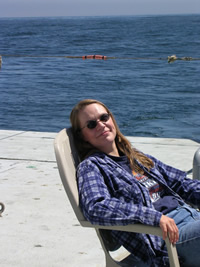


|
The Project
|
August 28, 2005
Percent of Light Today on the New Horizon, standing on the upper deck at high noon and looking around at the dense fog, I feel the chill of the sunless day. What a difference from yesterday when the sun shone bright during the lunch hour. The sun shines down on the Earth everyday with the same intensity yet the water droplets and the particles in fog and clouds of today have drastically changed the amount of light and heat that is getting through. The percent of light that we experience as we sit on the Earth at solar noon is different each day. The difference is due to the conditions in the atmosphere. Weather such as fog, rain, and clouds, and air pollution such as smoke, dust, and carbon dioxide can all affect how much sunlight gets through. The light and warmth that we feel is based on the light transmitted from the sun to the Earth through the atmosphere. Transmission of light from the sun can be measured as a percent of all the sun’s visible light (the light which we see). Nearly 100% of the visible light from sun hits the Earth’s atmosphere. This means that almost all (the whole amount) of the visible light reaches the outer surface of our atmosphere. The atmosphere absorbs and scatters some of the light so that only about eighty percent (80%) of the sun’s light reaches the surface of the Earth on a perfectly clear day at solar noon. In areas where the sky in hazy from pollution the light that reaches the Earth at noon may be only sixty percent (60%) of all the sun’s visible light. Dense fog further reduces this percentage to about twelve percent (12%). So, today only 12% of the available sunlight is reaching us and we still feel the cold that surrounded me from the dark night before. Basically, it hasn’t warmed up yet today and we, on the New Horizon, always hope for a little sunlight each day. All this is very similar to the measurements made by an instrument that we use called the transmissometer. The transmissometer, while underwater, shines a bright beam of light through a section of seawater. The amount of light that gets through the section of water is a measure of the clearness of the water and this amount of light is recorded on a computer. When there is a lot of plankton in the water the percent of light getting through is about 80 percent of the beginning intensity. On a graph the amount of transmitted light is plotted against depth. Generally, the transmission is lower (less light gets through) in the productive (full of life) surface water and higher (more light gets through) in the deeper, less productive water. Math: If the sun puts out 2500 units of visible light, calculate the amount of light getting through the atmosphere: Units of visible light on a bright sunny day = 60% of 2500 = To solve this problem you must change the percent into a decimal. Also remember: ‘of’ means multiply. You can also solve this problem using ratio proportion:60/100 =?/2500 - cross multiply and divide Try these: Units of visible light on a hazy day = Units of visible light on a foggy day = Now make a table (rows and columns of numbers) to show your results. This information can also be nicely displayed in a graph
|

